The world’s largest food company now prefers high-end business and small and medium-sized targets.
Editor’s note: This article comes from WeChat public account “Snack Generation” (ID: foodinc) , author Snack Generation.
Nestle, the world’s largest food company that made 661.9 billion yuan last year, will be more busy with asset acquisitions and divestitures this year. This is what Nestlé Global executives said.
At the 2020 New York Consumer Summit held recently, Nestle Chief Financial Officer Fançois-Xavier Rogerhe appeared with Sanjay Bahadur, Group Strategy and Business Development Leader, which is mainly responsible for mergers and acquisitions, and cooperation. Portfolio management drives growth, as well as this year’s acquisition strategy and direction.
Not long ago, as a Nestlé companion, PepsiCo announced that it would start with
François-Xavier Roger, Nestlé Chief Financial Officer
Snacks noted that Roger believes that Nestlé has a wide range of products. The three largest categories, including the coffee business, beverages, nutrition and health sciences, and pet care account for more than half of sales. But at the same time, the groupThe number of existing factories and employees is significantly reduced compared to four or five years ago. “This means that, although our sales have improved, our labor and capital intensity has been greatly reduced compared to a few years ago. ” He said.
Sanjay even bluntly announced, This year everyone will see more acquisitions and divestitures by Nestlé. He also focused on Nestlé’s evaluation criteria for acquisitions, also known as “more focused on medium-sized acquisitions than large-scale acquisitions.”
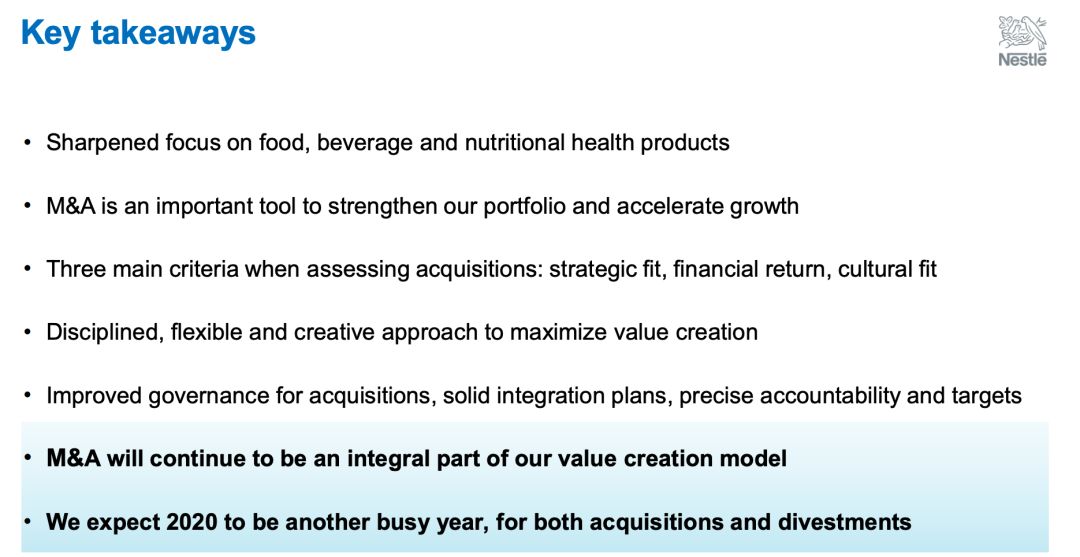
Let ’s take a look at the conference details with us.
Conclusion 1: There is still a chance for food to become a new brand
At the beginning of the meeting, Roger first talked about how Nestlé manages its existing product portfolio. He said that Nestle Group currently has 34 brands with sales of 1 billion US dollars. For example, Qifu, a subsidiary of Wyeth Nutrition, has entered the billion-dollar brand since last year.
“I’m often asked, can you develop new brands? This is a good example. ” He further explained, Qifu It did not exist 7 years ago, but in the Chinese market alone, this brand has developed into a billion-dollar brand after 7 years, fully showing the company’s capabilities.
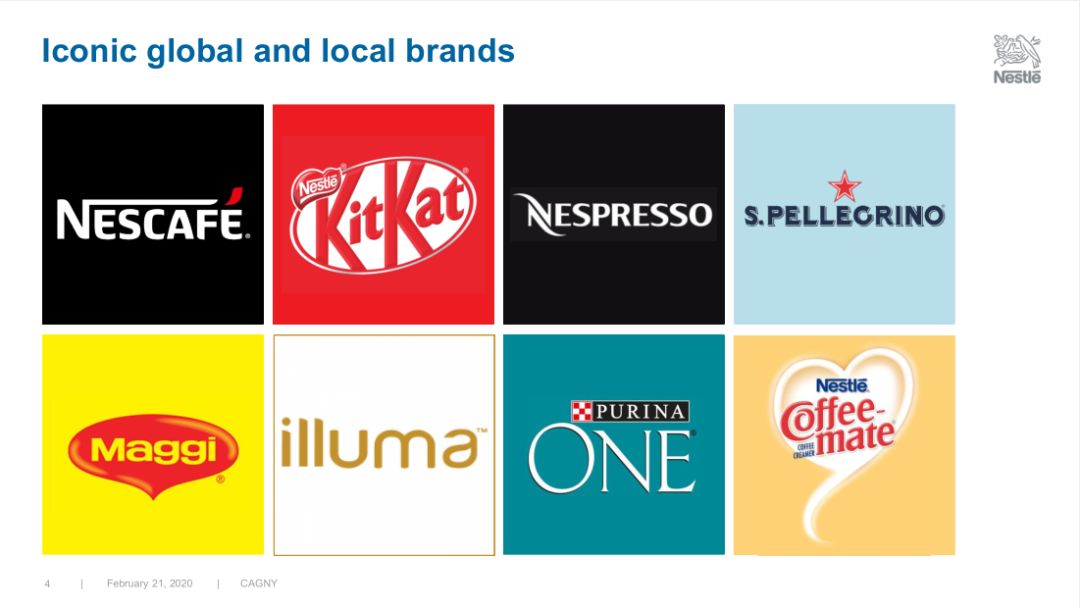
In Roger’s view, actively managing the existing product portfolio is an important way to drive growth and create value. “Our product portfolio is focused on growth, not accidentally, but through selection and design.”
According to the introduction, Nestle’s high-growth categories including pet care, water, baby nutrition, coffee and consumer health now account for 59% of sales. To the group average. If we exclude the slow-growing water business, growth has alreadyAfter reaching 5%.
He also pointed out that analysis shows that due to the relatively stable pricing over the past three years, Nearly two-thirds of Nestlé ’s growth has been based on portfolio strategies (including product categories, geography and products, etc.) It is a high-end product mix strategy. In addition, sales have increased year by year in the past three years.
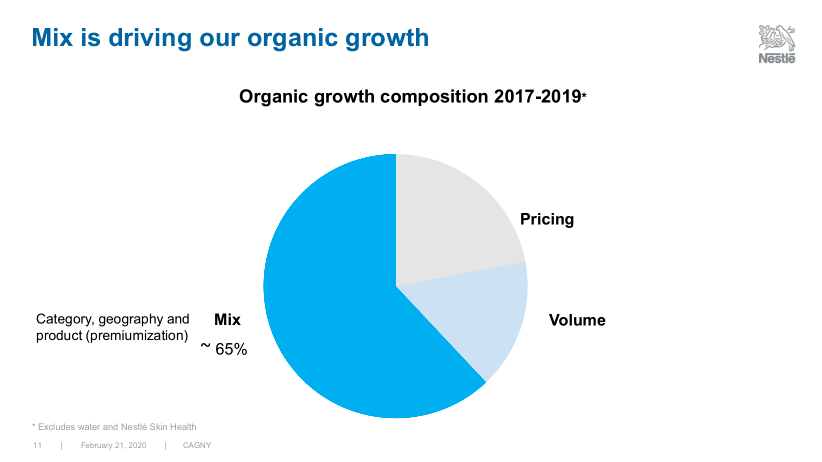
Dessert noted that when asked if Nestlé’s drinking water business would divest some of its popular products, Roger said that although this business, which was classified into the high-growth category, failed to meet expectations, some still had Attractive asset because does not want to divest the popular product category of the drinking water business.
“This category is still very attractive, based on two consumer trends, namely healthy drinking water in developed markets and safe drinking water in emerging markets,” he said.
In contrast, he also believes that the growth prospects of drinking water businesses in emerging markets with smaller volumes are more attractive.
Conclusion 2: High-end food is based on two major trends
According to reports, Nestle’s high-end products now account for 26% of total sales, compared with 11% in 2011. Roger further pointed out that high-end products brought about 4% profit growth. “We are moving away from the concept of just selling goods, and we are building brand equity. ” He said.
Roger believes that the effects of high-end strategies can be across categories and regions. Take coffee as an example. The company already has blue bottle coffee, strong coffee and Starbucks, which have enlightenment in baby nutrition, and KitKat in the candy category. This is true even in categories where performance is moderate, such as the drinking water business.
![In 2020, Nestle ushers in a]() He pointed out that the overall performance of Nestlé’s drinking water business was flat last year, but In particular, San Pellegrino, Paris Water and Acqua Panna, etc., achieved 8% -9% growth worldwide last year, while popular products declined.
He pointed out that the overall performance of Nestlé’s drinking water business was flat last year, but In particular, San Pellegrino, Paris Water and Acqua Panna, etc., achieved 8% -9% growth worldwide last year, while popular products declined.
From a geographical perspective, in the Chinese market, high-end products such as thick coffee, pet care, etc., and even Qifu, a brand with a sales volume of one billion dollars, have achieved double-digit growth, but most of them Popular products have all grown slowly and even declined.
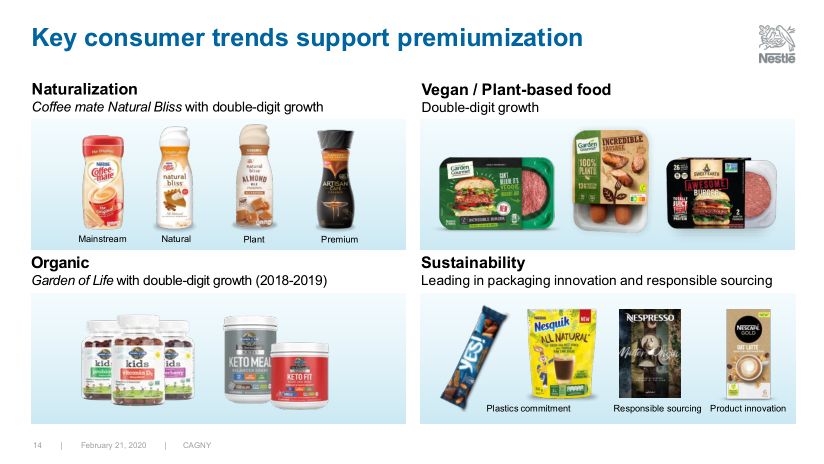
Roger also explained Nestlé’s understanding of the term “high-end”. He said that in fact, the promotion of high-end is based on two major trends, one of which is the core consumer trend. “We are working hard to promote consumer demand. People have a suppressed demand for natural products, and it is important to return.”
“ Another way to promote high-end is differentiation. ” Roger said. For example, the HMO formula product launched by Nestle Infant Nutrition has achieved sales of 850 million Swiss francs (equivalent to about 6 billion yuan) in the second year. The company’s hypoallergenic infant formula is also a considerable business.
Conclusion 3: China will eventually become the coffee market
In 2018, Nestlé signed a permanent global license agreement for Starbucks retail and catering products, granting Nestlé permanent ownership of Starbucks consumer products and catering services outside global coffee shops. This is regarded as a transaction sample for Nestlé to increase its coffee investment and pursue high-end.
At this conference, related product lines of Starbucks also attracted the attention of analysts. Some analysts asked, what is Nestlé’s China strategy in the Starbucks product line, and how do you view the prospects of China’s coffee market?
Roger said that last year the Starbucks product line achieved sales of 300 million Swiss francs and entered 40 countries. The product line has also expanded from the original 24 SKUs.
![In 2020, Nestle ushers in a]() He described China as an “interesting market”, just like Britain or Japan in the past. Traditionally, these markets belong to the tea culture market, but are gradually transforming into coffee markets. Nestle has played an important role in pushing Japan and the United Kingdom from the traditional tea market into the coffee market over the past few decades. “We are quite confident that we will eventually do this with other peers. ”
He described China as an “interesting market”, just like Britain or Japan in the past. Traditionally, these markets belong to the tea culture market, but are gradually transforming into coffee markets. Nestle has played an important role in pushing Japan and the United Kingdom from the traditional tea market into the coffee market over the past few decades. “We are quite confident that we will eventually do this with other peers. ”
Roger also cited the silver heron as an example. He said that Nestle’s ready-to-drink coffee beverages are also part of Yinlu’s business, which is also the highlight of Yinlu. The latter, as a beverage company, currently has the number one product in the Chinese ready-to-drink coffee market.
Conclusion 4: Acquisition must meet 3 criteria
Next, Sanjay talked to analysts in detail about Nestlé’s thoughts on M & A. “M & A will still be an important part of our value creation model. 2020 will start well, and we expect this year will be another busy year, including acquisitions and divestitures,” he said.
Sanjay said that For the first two years, Nestlé was more about adjusting its product portfolio and was more inclined to divest assets. But this year, the company hopes to refocus on acquisitions and strike a better balance between divestitures and acquisitions.
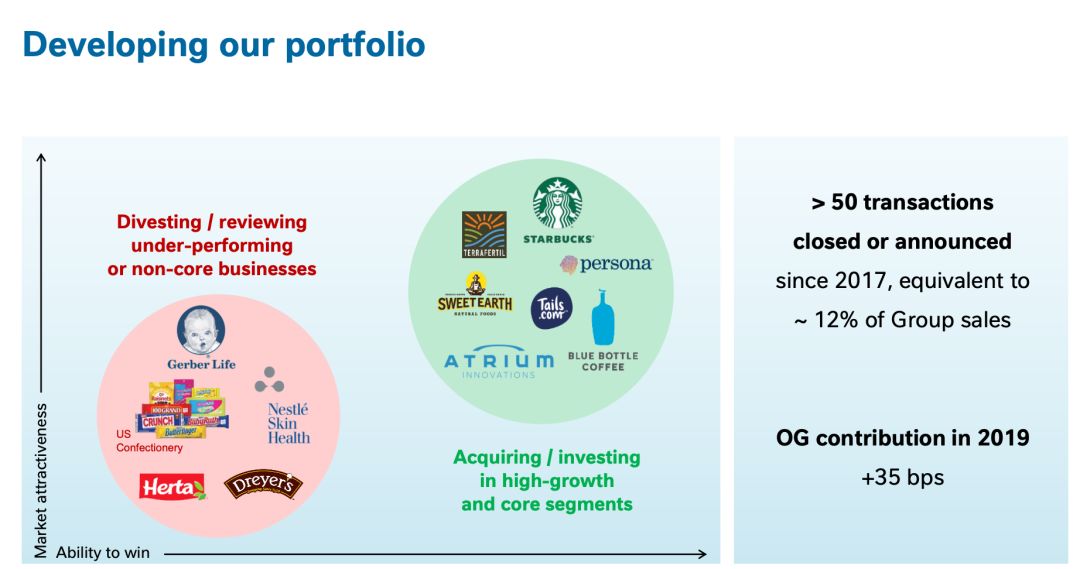
Data shows that since 2017, Nestlé has completed 50 transactions, which has changed its product portfolio by approximately 12% or sales of approximately 10 billion Swiss francs (about 69.6 billion yuan). “Most of these transactions are small and medium-sized, which is the most beneficial for Nestlé. ” He described that with further progress, 2020 will indeed see more transactions.
One example is January this year. Nestle announces its acquisition of Zenpep . Nestlé said this will enhance its growing portfolio of nutritional products.
“Zenpep is actually a series of enzymes or a combination of enzymes. It’s classified as a drug, but it’s really just an enzyme that really helps people digest food better. For our Nestlé Health Sciences business, it does It’s a good addition, “Sanjay explained at the meeting.
He also introduced in detail Nestle has three main criteria for evaluating acquisitions, including: Strategic fit, financial income, and cultural fit.
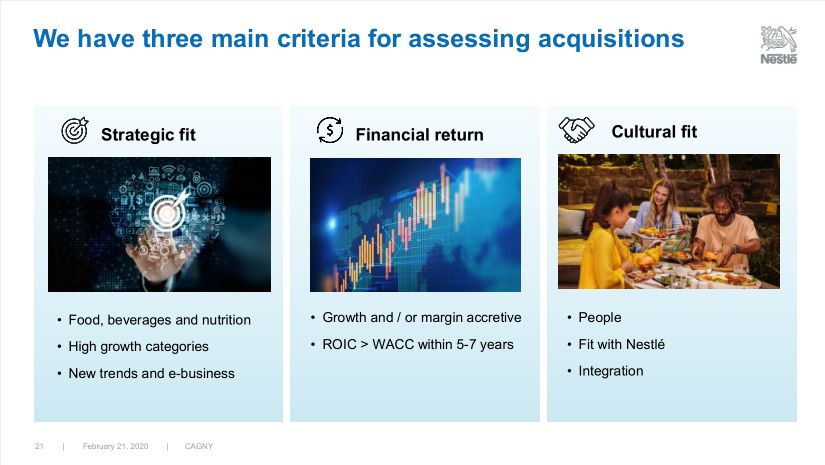
First, Sanjay said, Nestle wants to increase its focus on nutrition, health and wellness , and is focused on the food and beverage business. “We want to learn about new consumer trends and build strengths in existing areas. In general, what we have to do is invest in categories, geographic locations, or Channel. “
In addition, Nestle hopes that the business it acquires will not only increase profits but also achieve growth, “can achieve a return on investment capital within 5-7 years” . According to reports, Nestlé’s annual return on investment capital has improved over the past five years, and the company said that its medium-term goal is still to reach about 15%.
Finally, it is cultural fit. He believes that needs to evaluate those who are about to join the Nestlé organization, and their mentality and thinking are a very important part of the acquisition process, because this is the key to successful integration into Nestlé.

It is worth noting that in the past few years Nestle has been operating venture capital funds.
Introduction of Sanjay, the first investment is in a biotechnology fund called Flagship, which is investing in breaking technology companies in the field of nutrition science to match Nestlé Health Sciences . In addition, Nestlé has participated in Five Seasons, a European fund focusing on nutrition science, food and food technology, and has recently invested in a US fund called Powerplant ventures.
“Powerplant Ventures’ focus on investing in plant-based food and beverage companies has enabled us to gain all opportunities for innovation. This is a very high growth area and we are very happy with the initial investment,” he said.


According to reports, Nestle’s high-end products now account for 26% of total sales, compared with 11% in 2011. Roger further pointed out that high-end products brought about 4% profit growth. “We are moving away from the concept of just selling goods, and we are building brand equity. ” He said.
Roger believes that the effects of high-end strategies can be across categories and regions. Take coffee as an example. The company already has blue bottle coffee, strong coffee and Starbucks, which have enlightenment in baby nutrition, and KitKat in the candy category. This is true even in categories where performance is moderate, such as the drinking water business.
He pointed out that the overall performance of Nestlé’s drinking water business was flat last year, but In particular, San Pellegrino, Paris Water and Acqua Panna, etc., achieved 8% -9% growth worldwide last year, while popular products declined.
From a geographical perspective, in the Chinese market, high-end products such as thick coffee, pet care, etc., and even Qifu, a brand with a sales volume of one billion dollars, have achieved double-digit growth, but most of them Popular products have all grown slowly and even declined.

Roger also explained Nestlé’s understanding of the term “high-end”. He said that in fact, the promotion of high-end is based on two major trends, one of which is the core consumer trend. “We are working hard to promote consumer demand. People have a suppressed demand for natural products, and it is important to return.”
“ Another way to promote high-end is differentiation. ” Roger said. For example, the HMO formula product launched by Nestle Infant Nutrition has achieved sales of 850 million Swiss francs (equivalent to about 6 billion yuan) in the second year. The company’s hypoallergenic infant formula is also a considerable business.
Conclusion 3: China will eventually become the coffee market
In 2018, Nestlé signed a permanent global license agreement for Starbucks retail and catering products, granting Nestlé permanent ownership of Starbucks consumer products and catering services outside global coffee shops. This is regarded as a transaction sample for Nestlé to increase its coffee investment and pursue high-end.
At this conference, related product lines of Starbucks also attracted the attention of analysts. Some analysts asked, what is Nestlé’s China strategy in the Starbucks product line, and how do you view the prospects of China’s coffee market?
Roger said that last year the Starbucks product line achieved sales of 300 million Swiss francs and entered 40 countries. The product line has also expanded from the original 24 SKUs.
![In 2020, Nestle ushers in a]() He described China as an “interesting market”, just like Britain or Japan in the past. Traditionally, these markets belong to the tea culture market, but are gradually transforming into coffee markets. Nestle has played an important role in pushing Japan and the United Kingdom from the traditional tea market into the coffee market over the past few decades. “We are quite confident that we will eventually do this with other peers. ”
He described China as an “interesting market”, just like Britain or Japan in the past. Traditionally, these markets belong to the tea culture market, but are gradually transforming into coffee markets. Nestle has played an important role in pushing Japan and the United Kingdom from the traditional tea market into the coffee market over the past few decades. “We are quite confident that we will eventually do this with other peers. ”
Roger also cited the silver heron as an example. He said that Nestle’s ready-to-drink coffee beverages are also part of Yinlu’s business, which is also the highlight of Yinlu. The latter, as a beverage company, currently has the number one product in the Chinese ready-to-drink coffee market.
Conclusion 4: Acquisition must meet 3 criteria
Next, Sanjay talked to analysts in detail about Nestlé’s thoughts on M & A. “M & A will still be an important part of our value creation model. 2020 will start well, and we expect this year will be another busy year, including acquisitions and divestitures,” he said.
Sanjay said that For the first two years, Nestlé was more about adjusting its product portfolio and was more inclined to divest assets. But this year, the company hopes to refocus on acquisitions and strike a better balance between divestitures and acquisitions.

Data shows that since 2017, Nestlé has completed 50 transactions, which has changed its product portfolio by approximately 12% or sales of approximately 10 billion Swiss francs (about 69.6 billion yuan). “Most of these transactions are small and medium-sized, which is the most beneficial for Nestlé. ” He described that with further progress, 2020 will indeed see more transactions.
One example is January this year. Nestle announces its acquisition of Zenpep . Nestlé said this will enhance its growing portfolio of nutritional products.
“Zenpep is actually a series of enzymes or a combination of enzymes. It’s classified as a drug, but it’s really just an enzyme that really helps people digest food better. For our Nestlé Health Sciences business, it does It’s a good addition, “Sanjay explained at the meeting.
He also introduced in detail Nestle has three main criteria for evaluating acquisitions, including: Strategic fit, financial income, and cultural fit.

First, Sanjay said, Nestle wants to increase its focus on nutrition, health and wellness , and is focused on the food and beverage business. “We want to learn about new consumer trends and build strengths in existing areas. In general, what we have to do is invest in categories, geographic locations, or Channel. “
In addition, Nestle hopes that the business it acquires will not only increase profits but also achieve growth, “can achieve a return on investment capital within 5-7 years” . According to reports, Nestlé’s annual return on investment capital has improved over the past five years, and the company said that its medium-term goal is still to reach about 15%.
Finally, it is cultural fit. He believes that needs to evaluate those who are about to join the Nestlé organization, and their mentality and thinking are a very important part of the acquisition process, because this is the key to successful integration into Nestlé.

It is worth noting that in the past few years Nestle has been operating venture capital funds.
Introduction of Sanjay, the first investment is in a biotechnology fund called Flagship, which is investing in breaking technology companies in the field of nutrition science to match Nestlé Health Sciences . In addition, Nestlé has participated in Five Seasons, a European fund focusing on nutrition science, food and food technology, and has recently invested in a US fund called Powerplant ventures.
“Powerplant Ventures’ focus on investing in plant-based food and beverage companies has enabled us to gain all opportunities for innovation. This is a very high growth area and we are very happy with the initial investment,” he said.
Next, Sanjay talked to analysts in detail about Nestlé’s thoughts on M & A. “M & A will still be an important part of our value creation model. 2020 will start well, and we expect this year will be another busy year, including acquisitions and divestitures,” he said.
Sanjay said that For the first two years, Nestlé was more about adjusting its product portfolio and was more inclined to divest assets. But this year, the company hopes to refocus on acquisitions and strike a better balance between divestitures and acquisitions.

Data shows that since 2017, Nestlé has completed 50 transactions, which has changed its product portfolio by approximately 12% or sales of approximately 10 billion Swiss francs (about 69.6 billion yuan). “Most of these transactions are small and medium-sized, which is the most beneficial for Nestlé. ” He described that with further progress, 2020 will indeed see more transactions.
One example is January this year. Nestle announces its acquisition of Zenpep . Nestlé said this will enhance its growing portfolio of nutritional products.
“Zenpep is actually a series of enzymes or a combination of enzymes. It’s classified as a drug, but it’s really just an enzyme that really helps people digest food better. For our Nestlé Health Sciences business, it does It’s a good addition, “Sanjay explained at the meeting.
He also introduced in detail Nestle has three main criteria for evaluating acquisitions, including: Strategic fit, financial income, and cultural fit.

First, Sanjay said, Nestle wants to increase its focus on nutrition, health and wellness , and is focused on the food and beverage business. “We want to learn about new consumer trends and build strengths in existing areas. In general, what we have to do is invest in categories, geographic locations, or Channel. “
In addition, Nestle hopes that the business it acquires will not only increase profits but also achieve growth, “can achieve a return on investment capital within 5-7 years” . According to reports, Nestlé’s annual return on investment capital has improved over the past five years, and the company said that its medium-term goal is still to reach about 15%.
Finally, it is cultural fit. He believes that needs to evaluate those who are about to join the Nestlé organization, and their mentality and thinking are a very important part of the acquisition process, because this is the key to successful integration into Nestlé.

It is worth noting that in the past few years Nestle has been operating venture capital funds.
Introduction of Sanjay, the first investment is in a biotechnology fund called Flagship, which is investing in breaking technology companies in the field of nutrition science to match Nestlé Health Sciences . In addition, Nestlé has participated in Five Seasons, a European fund focusing on nutrition science, food and food technology, and has recently invested in a US fund called Powerplant ventures.
“Powerplant Ventures’ focus on investing in plant-based food and beverage companies has enabled us to gain all opportunities for innovation. This is a very high growth area and we are very happy with the initial investment,” he said.